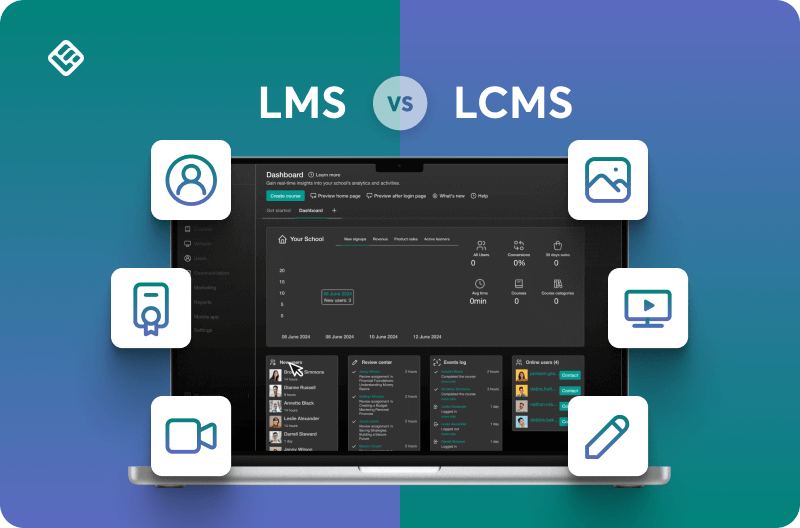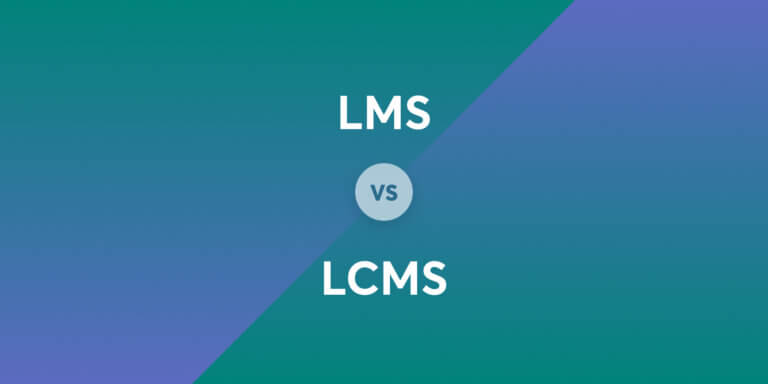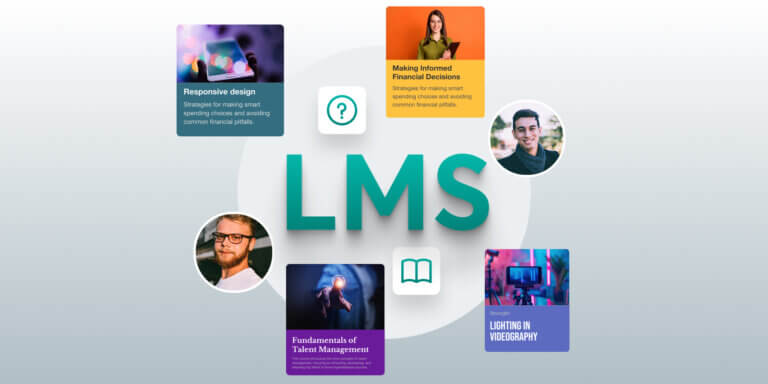Table of Contents
Crazy to think about it, but the online learning platform you choose can make the difference between a dull experience and a rocket-ship full of knowledge.
Think about trying to teach a dog to fetch with only a leash.
That’s how different a learning management system (LMS) and a learning content management system (LCMS) are. Both are perfect tools for meeting workforce learning needs, but you should know they focus on different needs.
Here’s a look at the LMS vs LCMS differences and use cases to help you choose your own.
Understanding the learning tech landscape
The learning technology landscape is as fluid as you’re envisioning it. With artificial intelligence-based resources, immersive experiences, and data-driven products, digital learning content and training programs have never been easier to personalize.
Similarly, virtual and augmented reality (VR and AR, respectively) platforms offer immersive simulations for programs in medicine, engineering, and soft skills training. Not surprisingly, learning management systems have also adapted some of these new capabilities, maturing into more holistic ecosystems to support learning experiences and gathering analytics to monitor students’ learning journey.
So, where are we going in the entire learning content lifecycle?
The future of learning lies in hyper-personalization and experiential learning. Micro-credentialing, skill badges, and just-in-time learning dictate how the education experience progresses based on user demand and availability of training content.
Added to this, expect a tighter focus on social learning features and more support tools that allow educators to track the cognitive skill capacity and emotional skill development.
The biggest challenge here?
Not everyone has access to the same technologies. Regulatory personal data privacy laws can prevent in-depth learner progress analysis. This comes with catastrophic results on getting a good understanding of why learner disengagement happens and how you can prevent it.
Flexibility is key. And that’s just why we’re looking into the LCMS vs LMS comparison.
Why compare LMS and LCMS?
Let me start with this: The LMS vs LCMS debate is only valid once you’ve clearly understood what direction you want your training priorities to go in.
Your final decision entirely depends on your organization’s training goals and what resources you already have at hand. An LMS works well for organizations in compliance-oriented sectors and for onboarding new employees.

An LCMS provides more comprehensive and scalable authoring tools. This is well suited for continuous content development, or if you want to give your employees personalized learning content that they can access on demand.
Money is another important consideration. LMS systems are typically easier to use, while LCMS systems often require complex, costly setups. Some LMS platforms also combine both systems into one to give you more options regarding content delivery and reporting on learning.
But beyond it all, to ensure the LMS or LCMS you choose meets your organization’s long-term training needs, you should first assess your content requirements, determine how scalable a new solution would be, and even consider potential third-party integrations.
Let me take you through how each one of them can help you, because, yes, they do come with unique advantages.
What is an LMS (Learning Management System) for online learning businesses?
A learning management system is a platform that helps businesses deliver, manage, and track online education efforts such as courses, mentorship opportunities, or onboarding flows.
When switching to a new LMS, look for essential features such as:
As for the nice-to-haves, think strong mobile-friendly functionality, gamification, and certification options.
Companies that provide online learning content or formal learning development will find LMS platforms extremely valuable. For them, LMS platforms will provide unique benefits, including automation, scalability, and extensive analytics.
💁What is a learning management system (LMS)? Learn more about its different types and benefits.
💁 Interested in an AI LMS? Compare the top 5 options.
What is an LCMS (Learning Content Management System)?
A learning content management system strictly focuses on how you can create, manage, and deliver elearning content by using core functionalities such as content authoring.
Content creation in LCMS leads to scalable and engaging courses for your learners. This means maximum flexibility and productivity in any content-driven training solutions. Managing learning materials with LCMS becomes easy, too. The LCMS’s unique capabilities are a blend of many things, but the basic features include strong content authoring for SCORM-compliant courses and a repository for storing and reusing assets.
All of the features are perfect for learning and development organizations that provide tailored training solutions, certifications, or specific training courses created for particular industries (like healthcare, finance, and manufacturing). Plus, you can also consider LCMS for instructional design.
Organizations with content teams that work in-house or have complicated learning strategy needs can also take advantage of an LCMS’s customizability.
LMS vs. LCMS: Key similarities and differences
If you’ve noticed one thing by now is that both learning management systems and learning content management systems support learning in unique ways. Both, though, eliminate the headaches of setting up and tracking course progress.
However, an LMS is the best option for administration, while an LCMS is best suited for developing content.
Let’s take a deeper dive:
Content management and delivery
Similarities: Both provide the tools you need to manage and deliver digital content, supporting various formats such as SCORM and mobile delivery.
Differences: An LMS is focused on organizing and delivering prebuilt courses, hence, it has limited authoring capability. An LCMS simply provides users with a central location to create, store, and update content.
💡See how LearnWorlds is an exception to the rule and learn how you can use the versatility of our platform’s SCORM/HTML5 compliance to easily import your content into your online school.
Learner tracking and reporting
Similarities: Both provide analytics to monitor learner progress, completion rates, and performance levels.
Differences: While learning management systems like LearnWorlds provide thorough reports on compliance and engagement, learning content management systems strictly focus on learner engagement with your content.
In other words, the latter focuses on helping you improve the effectiveness of content, while an LMS takes a more holistic approach, supporting improvements within the entire learner experience.
Collaboration and content creation
Similarities: Both support team content creation workflows.
Differences: Traditional LMS tools don’t provide much when it comes to authoring and depend on other tools to create content. An LCMS provides collaborative authoring, version control, and personalization, allowing teams to build the content and tailor it to their learners.
What is SCORM compliance?
You’ve already seen me mention SCORM compliance. That’s because, quite frankly, it’s a must.
When discussing SCORM (Sharable Content Object Reference Model), we’re describing a technical standard set to guarantee elearning content is interoperable on different platforms. For the general public, this means that course resources, like video or quizzes, can all be packaged and reused in SCORM-compliant systems.

SCORM provides standardized content importing, delivery, and tracking to learning management systems like LearnWorlds. The SCORM output is what keeps training courses running, so you can use them in any way you want.
The best learning management systems and learning content management systems today rely on SCORM to support compatibility, maintenance, and workflow optimization.
It’s a non-negotiable.
SCORM compliance practically guarantees flexibility, scalability, and cost savings in creating and delivering employee training materials. It also provides you with assurance that your learners’ progress is being tracked accurately. This is critical for compliance-driven organizations in industries such as healthcare or finance.
LMS vs. LCMS: Which solution is right for you?
Whether you choose an LMS or an LCMS depends entirely on your organization’s training goals, content requirements, and resources.
An LMS output is focused on providing and reporting on the progress in existing courses. An LCMS output, on the other hand, focuses on developing, managing, and customizing the training content. What matters above all else is your priorities, such as whether administration or content development is more important to you.
When deciding between an LMS and an LCMS, the granularity of learning analytics is crucial. A standout feature of an LCMS is its ability to track detailed interactions, like who accessed or edited specific parts of a module and when. This is invaluable for situations demanding precise auditing or swift compliance, giving organizations a clear view of content use and modifications.
Speaking of focus, choose an LMS if your focus is on efficient course delivery, user management, and compliance tracking. It’s ideal for businesses in regulated industries, such as healthcare or manufacturing, that need consistent onboarding or regulatory-based training.
Choose an LCMS for its dynamic content creation capabilities, personalization, and content reusability. This is a perfect fit for businesses in the technology and education space looking to create personalized courses that will inevitably scale together with your team. Avoid using just an LCMS if your team doesn’t have strong authoring skills or if you’re primarily looking to deliver static content.
To avoid making the wrong choice, it is important to understand the actual process of working with your team’s content. For example, if you are constantly creating, adapting, and localizing training materials for different teams, I recommend using LCMS. However, if your company is more focused on structuring, customizing, and certifying training, then an LMS would be the best choice.
Now you’ve been waiting for this the whole time: Yes, you can use both.
In fact, LearnWorlds helps you meet both ends of the spectrum by helping you:
If you’re looking for an out-of-the-box delivery system, LearnWorlds is an excellent LMS that lets you manage your courses, track learner progress, issue certificates, and create extensive professional learning paths.
It has the built-in tools needed for creating interactive learning content, so you don’t need to turn to other solutions.
Final thoughts on making the right choice for your learning needs
Remember what I mentioned at the very beginning of this LMS vs LCMS comparison? Learning activities and needs matter before all else.
What is it that your learners want to work on? What are your main professional targets for your workforce? Is your focus on skills development, compliance training, leadership, product knowledge, or perhaps all?
Your answers will tell you exactly what tool you need.
Get a free trial with LearnWorlds today and start providing training that improves your learner engagement and brings better results.

Alexandra Cote
Alexandra Cote is a SaaS growth marketer and online instructor who's worked with dozens of brands in the MarTech, HR tech, and productivity space. She's also a strong supporter of staying happy at work and choosing a healthy career path.



